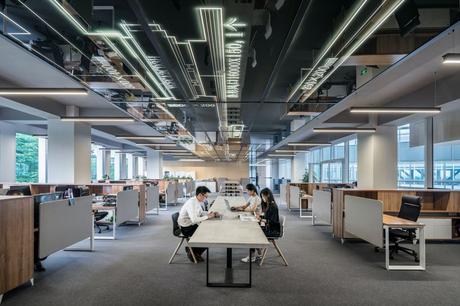
I recently transitioned into a new role at the university. With that transition came the move to a new office on campus. I will admit to being initially hesitate to move, in large part because it meant being on campus considerably more than had been the case for the previous three years. I had grown to truly appreciate the flexibility and focus that working from home provided for me. However, the prospect of being in a space with other colleagues again was exciting.
What's more interesting is that my office is located in a larger office and community space that was recently built. The smell and look of "newness" permeates the space, and there is a great deal of potential filling every corner of the space. When I arrived, I was relieved to discover that the staff offices were separate and discrete. They were still quite accessible and easy to access, but offered a welcome level of privacy at the same time. This decision was no doubt made after first considering the move to an open office configuration, which continues to be a popular framework for office redesigns.
As the logic goes, removing doors and walls will allow folx to connect and collaborate more easily, leading to the generation of more ideas and an increase in productivity. In theory, an open office environment also removes the hierarchy that is generated by physical office layouts. However, the result has been less than optimal since companies began moving to open office environments. As such, we've been seeing backlash for the better part of a decade.
Part of what designers got wrong about this organizational trend was the reality of human behavior. As anyone who has ever suffered through an uncomfortable social situation knows, we are good at avoiding interaction if we don't want to connect. We avert our eyes, pretend to pay attention to something we aren't, or simply move about a space in such away as to minimize interaction. What's more, we all have a built in distraction at the ready in the form of our phones. When we want to interact, we make that choice. It's rarely made for us. I'm sure most of us are waiting for replies to emails we sent days or weeks ago. I can almost guarantee you the other person read that message. Their lack of reply is a choice.
What's more, we tend to become even better at tuning out those around us as the number of people around us increases. We are, in effect, erecting the fourth wall in order to focus. This is no doubt why researchers have discovered that folx have less face-to-face interactions after a move to an open office environment. What's even more interesting is that digital communication increases significantly after a move as well. We are literally closer to our colleagues, can often see them within our line of sight, and elect to send them an email instead of walking over and talking to them. This reaction brings back memories of my time working in the residence halls, mediating roommate disagreements that were taking place entirely through AOL Instant Messenger (remember the CDs you got in the mail?).
If anything, the enormous shift to remote work should serve as the final blow to open office designs. We collectively discovered that we were often more productive, less distracted, and more satisfied with our jobs when we had the option to do some or all of our work from home. Now, some of that is no doubt based on the ability to work in your PJs, but there's clearly more to it. The recent high vacancy levels of office space in New York City and other major markets is further evidence that remote work is here to stay.
My transition to this new role has meant moving back to a more student-facing position after many years working almost exclusively with faculty and staff. This has meant more time in the office for obvious reasons. Despite the move to online learning and remote work, the reality is that physical proximity continues to be important to the higher education experience. Offices are not going anywhere anytime soon, and I will continue to value the face-to-face interactions I have with students and colleagues. Thankfully, I can also shut the door to my office when I want to concentrate or take a private meeting. As it turns out, having an office makes me more likely to leave it and seek out face-to-face contact. I'm thankful for the opportunity to connect on a deeper level with colleagues. As it happens, I'm also thankful for the architect that saw the writing on the wall and included dedicated offices in our new, beautiful space!
